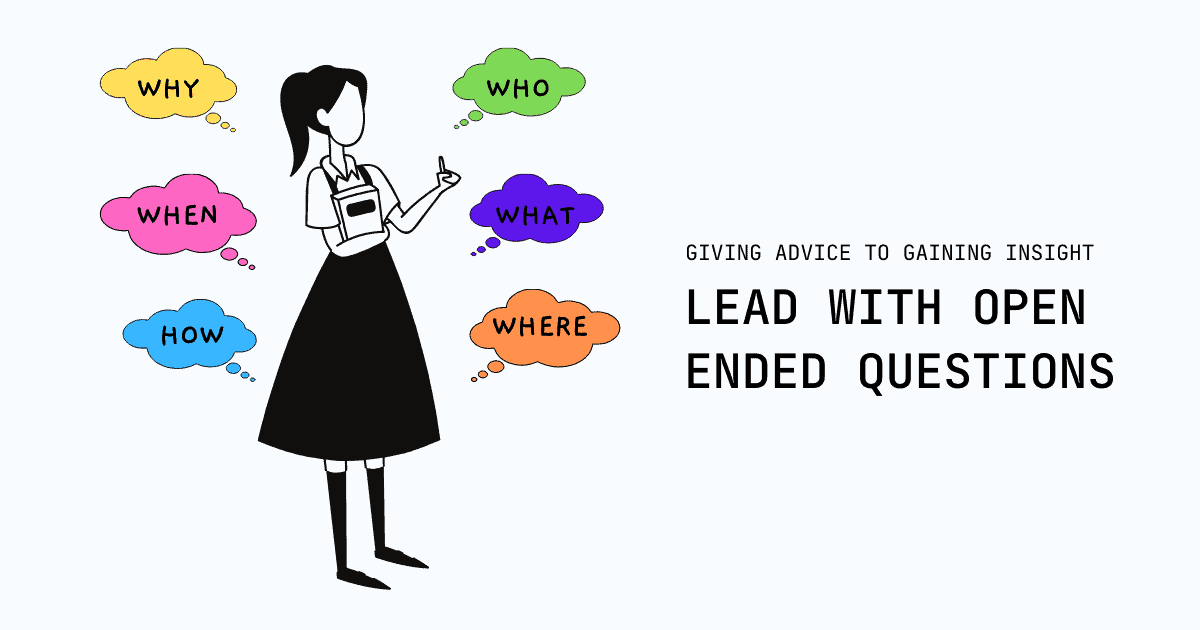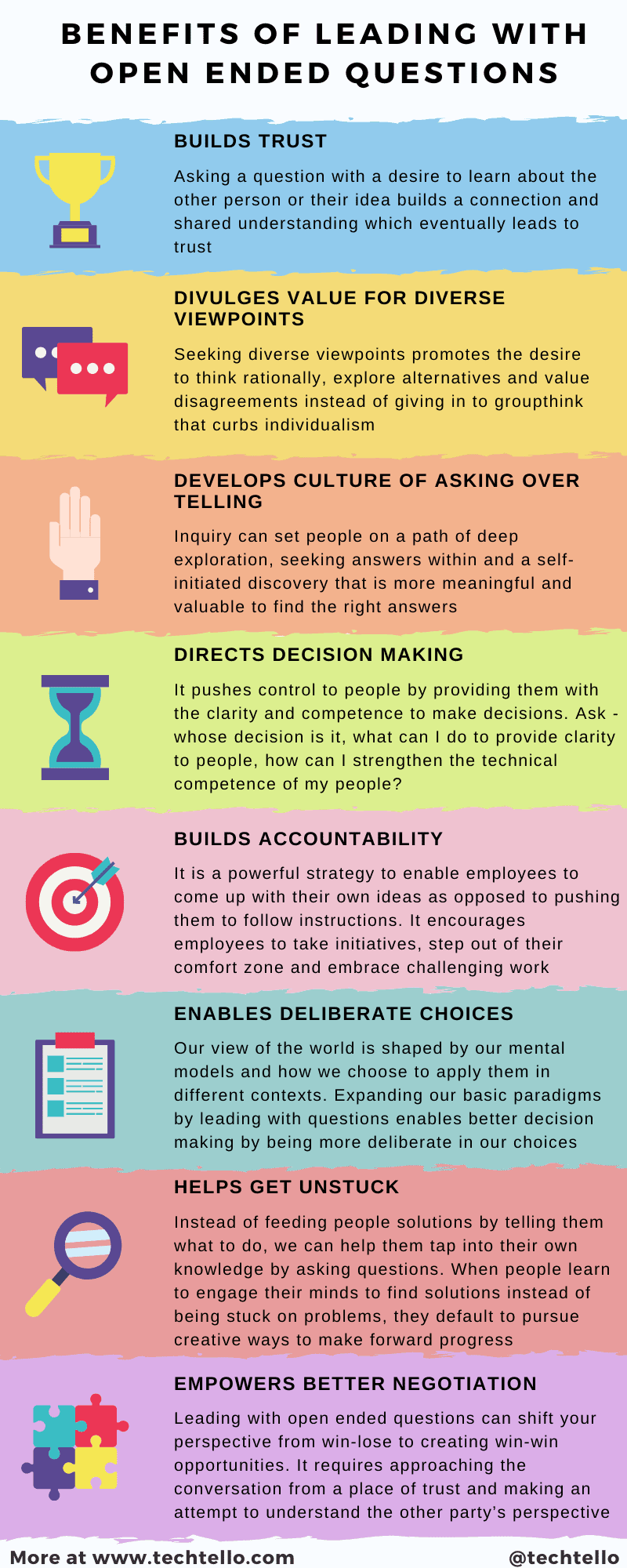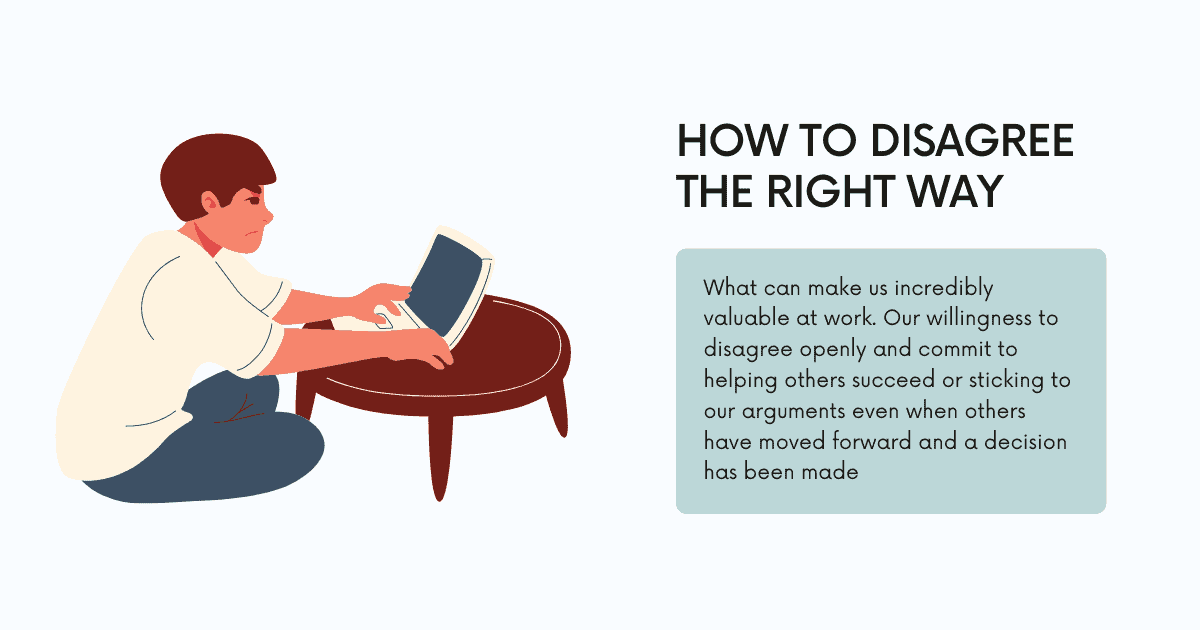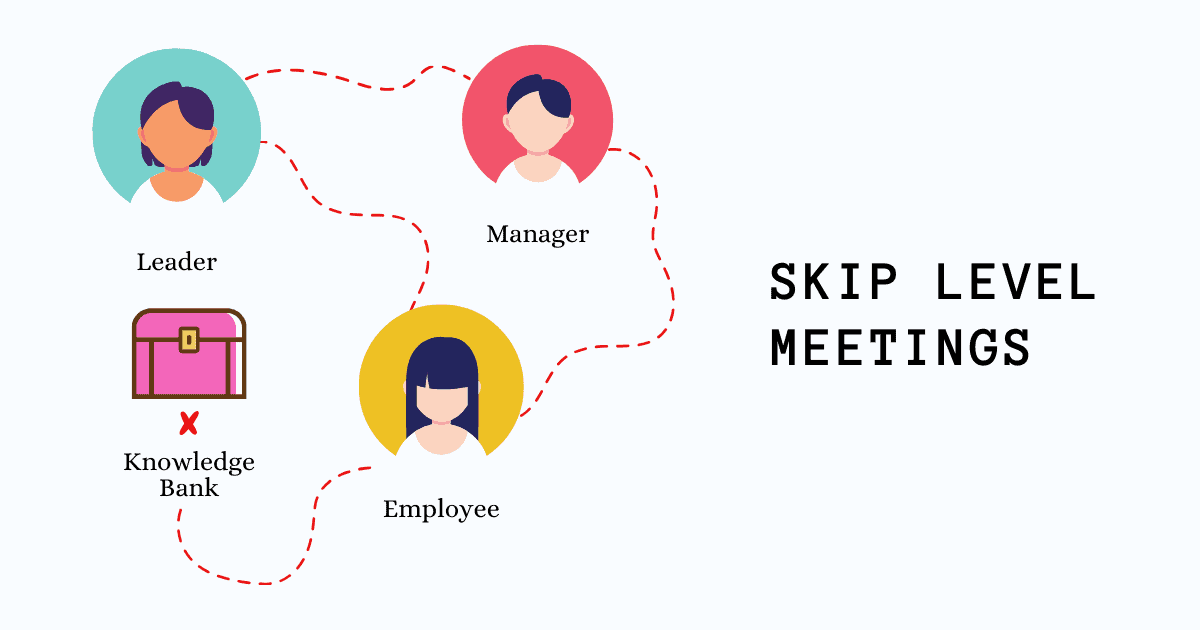Leading With Open Ended Questions: Giving Advice To Gaining Insight

Have you noticed what happens when someone asks you a really good open ended question? Your mood shifts and body language changes as your mind sets on a quest to look within, think deeply, and churn out ideas. The endorphin rush that comes from exploring uncharted territories triggers a positive feeling in the body.
Good open ended questions encourage people to indulge in storytelling and forming new connections. It motivates action, builds trust, and promotes accountability.
Yet, people who have all the answers are favoured over those who indulge in deliberate thinking. Answers and not questions have become the hallmark of great leadership.
With a culture that promotes giving advice as opposed to enabling people and setting them on a path of self-discovery, giving instructions and telling people how to do their jobs has become the norm.
It leads to developing executioners as opposed to innovators, shallow thinkers who are too lazy to look at all sides of an issue as opposed to deep thinkers who analyse all possible effects and outcomes, decision-makers who consider success by the number of decisions they make as opposed to the quality of those decisions and a workforce who considers not knowing as a sign of weakness as opposed to an opportunity to build skills and learn something new.
Google’s CEO, Eric Schmidt, said “We run this company on questions, not answers” because it’s the mindset to engage and curiosity to ask open ended questions that encourages dialogue and exchange of opinions.
Lead with questions and not with answers, shift from giving advice to gaining insight, and from knowing to learning through others.
Get your FREE copy of the master guide of 150+ open ended questions at the end of this article.
8 benefits of leading with open ended questions

1. Builds trust
Good open ended questions asked out of genuine curiosity triggers an interest in the other person. It shows that you respect their input and value their opinion.
As humans, we seek validation based on how others interact with us. “Being heard” is one of the core needs of every human being. There’s no better way to build trust than to give an opportunity to the other person to speak, actively engage by listening to them and asking good follow-up questions.
The simple act of asking a question with a desire to learn about the other person or their idea builds a connection and shared understanding which eventually leads to trust.
Dale Carnegie advised this in his book, How to Win Friends and Influence People
Remember that the people you are talking to are a hundred times more interested in themselves and their wants and problems than they are in you and your problems. A person’s toothache means more to that person than a famine in China which kills a million people. A boil on one’s neck interests one more than 40 earthquakes in Africa. Think of that the next time you start a conversation
Consider this. Your colleague is back from a camping trip in the mountains. While a question like “How was your camping trip” will typically elicit a simple response like “good/bad”, an open ended question like “What did you do on the camping trip” will make them draw out experiences from their memories that they consider worth sharing with others.
The impact of such conversations can be realised in the future where both the parties will be more receptive and open to sharing information in other contexts.
Building trust may take some more time, but it will be the first step in the right direction and a validation of the value of asking good open ended questions.
2. Divulges value for diverse viewpoints
Good open ended questions shift our focus from what we know to what we do not know. It allows us to draw on the collective knowledge of people in the organisation instead of being limited by our beliefs and assumptions.
Seeking diverse viewpoints not only expands our mental models, it promotes dialogue and engagement in the organisation.
It promotes the desire to think rationally, explore alternatives, value disagreements and seek fresh perspectives instead of giving in to groupthink that curbs individualism and leads to conservative thinking.
As part of a group discussion, asking “Does anyone disagree” may inhibit people from sharing their true opinion, while an open ended question like “Share your opinion on how you see this decision and why” will encourage everyone to inquire and provide a more honest point of view.
3. Develops culture of asking over telling
Stephen R. Covey’s brilliant advice in The 7 Habits of Highly Effective People “Seek first to understand then to be understood” if applied well can create a culture where learning by asking questions is encouraged over the impulsive tendency to provide answers.
The desire to fix others creates a rush which prompts us to share our experience even though the other person may be simply looking for an opportunity to be heard. Our intention in the moment may not be wrong as we act out of our natural instinct to save others, but it may do no good to the other person.
Taking a step back in such moments and instead leading with an open ended question can set them on a path of deep exploration, seeking answers within and a self-initiated discovery that is more meaningful and valuable to find the right answers.
Sometimes the path taken to reach answers is more useful than the answers itself. A culture where everyone leads with questions enables a collaborative mindset and approach conflict with a desire to understand the other person instead of shutting them down and labeling them as difficult people.
4. Directs decision making
Most organisations operate by pushing decisions to the top as opposed to using an opportunity to push decisions to the next lower levels in the organisation where the information lives.
L. David Marquet succinctly expressed this in his book Turn The Ship Around
Worry that stems from delegating decisions in organisations falls into two categories – Issues of competence and issues of clarity. People are worried that the next level down won’t make good decisions, either because they lack the technical competence about the subject or because they don’t understand what the organization is trying to accomplish. Both of these can be resolved
Giving up control requires leading with open ended questions:
- Whose decision is it?
- What can I do to provide clarity to people who need to make those decisions?
- How can I strengthen the technical competence of my people?
Leading with open ended questions pushes control to people by providing them with the clarity and competence to make those decisions.
5. Builds accountability
Ever noticed how the attachment to our own ideas creates the necessary drive to put in our best effort as opposed to executing someone else’s plan.
Even a tiny little progress on our ideas releases dopamine in the brain. The feeling of pleasure and satisfaction that comes from small achievements on our goals forms part of a reward system that generates a positive feedback loop motivating us to work harder.
Leading with open ended questions is a powerful strategy to enable employees to come up with their own ideas and solutions as opposed to pushing them to follow instructions.
It encourages employees to take initiatives, step out of their comfort zone and embrace on more challenging work. Some great open ended questions to ask to build accountability in the organisation includes:
- How do you plan to solve this problem?
- Tell me more about your thought process
- Describe this issue you are facing
- What are some of the solutions you have tried?
- When do you think will be the right time for us to demo this feature?
- Where can we find more information on this idea?
- Share with me your thinking that went into designing this product
- Who can be helpful to share ideas on this work?
- Explain how you intend to grow in your role
6. Enables deliberate choices
Our view of the world is shaped by our mental models and how we choose to apply them in different contexts.
Everything that we believe to be true is just our perspective, our own view of reality. Programmed with multiple biases, we also tend to limit our own options by believing that’s all that exists.
Confirmation bias limits us by seeking information we believe to be true. Availability bias makes us give more importance to recent events thereby disregarding other important events in our life that might be more valuable in the moment. Each bias in some way confines us instead of expanding our zone of knowledge.
Instead of being limited in our choices, we can explore the vast world of possibilities by employing open ended questions while making decisions:
- Why do I think this way?
- What if my decision is wrong?
- Are there other possible alternatives?
- What are the second order consequences of my decision?
- What do others have to say about my decision?
- What’s the worst that can happen if I do not go with this decision?
- How can others be impacted by my decision?
- What can I do to validate my assumptions?
Warren Berger in, A More Beautiful Question
Most creative, successful business leaders have tended to be expert questioners. They’re known to question the conventional wisdom of their industry, the fundamental practices of their company, even the validity of their own assumptions
Expanding our basic paradigms by leading with open ended questions enables better decision making by being more deliberate in our choices.
7. Helps get unstuck
How can we enable employees to develop critical thinking skills, become good problem solvers, and approach work with a growth mindset as opposed to a fixed mindset?
Instead of feeding people solutions by telling them what to do, we can help them tap into their own knowledge by leading with open ended questions.
Asking people questions when you already know the solution (or so you believe) may seem like a waste of time, but it’s what’s required to develop leaders and not followers.
When people learn to engage their minds to find solutions instead of being stuck on problems, they default to pursue creative ways to remove blockers and make forward progress.
Some leading open ended questions to develop critical thinking skills in your organisation includes:
- What prevents you from moving forward?
- How can you try something new to change your current situation?
- What resources do you need to find solutions?
- Why do you think this is the only possible path?
- What will be the effect of staying where you are as opposed to taking action?
- What does this situation teach you about yourself?
8. Empowers better negotiation
Most people believe that negotiation is a win-lose game in which one party must lose for the other to win.
The mindset to win can make you hide facts, stick to what you know as opposed to making an attempt to understand the other person and their wants, speak up more than listen and even question their intent.
Leading with open ended questions can shift your perspective from win-lose to creating win-win opportunities. It requires approaching the conversation from a place of trust, making an attempt to express your preferences while also trying to understand the other party’s perspective, and listen intently with a desire to collaborate and explore possible solutions together.
Leading a negotiation with these open ended questions can be beneficial for both the parties:
- What do you intend as the outcome of this discussion?
- How can we find a solution that benefits us both?
- How do you suggest we approach this?
- Tell me more about your proposal
- Explain how this proposal can be useful to both of us
- What problems do you see with this solution
- Share with me your approach to reach this conclusion
What makes up for good open ended questions?

1. Make it clear and concise
Keep the language of the question simple and easy to understand. It should not be vague or lacking context and should be expressed in a tone that invites the other person to feel safe to open up and share their opinion.
We may not realise it, but how we frame the question plays a large role in how others perceive us, our intent and how they engage with us.
There’s a lot of difference in saying –
Bob, can you ever do your job well?
vs
Bob, I have been noticing that your last few deliverables have missed their deadline. What is preventing you from keeping your commitments?
The first question seems like an attack – it’s vague, lacks clarity on the specific issue and what you expect Bob to answer. The second question encourages him to think deeply about his missed deliverables and share insights that can be useful to find solutions and help Bob become better at his job.
2. Avoid double-barreled questions
When the issue or topic requires more than one line of discussion, we often bring them up at the same time. This leads to confusion, the possibility of only one getting the necessary attention and the other getting ignored and the assumption that the answer applied to both of your inquiries while it was applicable to only one of them.
Asking double-barreled questions may render the question useless by asking the other person to respond to two questions at once which in most cases is not possible. Break your line of inquiry to address only one line of thinking and once you have explored that in-depth, move on to the next one.
Consider,
Laura, how do you intend to structure that report and the presentation for our upcoming conference?
vs
Laura, how do you intend to structure that report?
Laura, what’s your thought process about the presentation for our upcoming conference?
The first question combines two themes and expects one answer while in reality both require independent discussion. Asking the two questions separately gives an opportunity to the other person to dive deep into each requirement and put forward their point of view on the subject under consideration.
The conversation will be richer, directed towards a specific problem, and will have a higher likelihood of reaching a conclusion.
3. Keep it free of bias
Our biases rule our lives in how we experience things around us, think, and act.
The questions we ask are not free from this bias. Confirmation bias leads us to ask questions that confirms our belief, availability bias makes us drift towards more recent events and frame our questions that are influenced by those events and fundamental attribution error makes us overemphasize personality and underestimate situational factors when expressing our understanding using questions.
Asking unbiased, un-opinionated questions that are free of judgement and assumptions requires us to question our own questions. It’s not easy and does require a lot of practice, but with time it can be mastered.
Ask questions that do not lead to the answers you seek, consider a larger context instead of being driven by recent events and take into account the situation and other environmental factors instead of assuming it’s a person’s behaviour.
Jonas, our last meeting sucked because of Anna’s behaviour. What do you think?
vs
Jonas, what do you think about our last meeting?
The first one has confirmation bias and fundamental attribution error at its core, while the second question is free of bias and invites Jonas to share his viewpoint without being directed to a specific line of thinking.
4. Make it engaging
This one cannot be explained without citing Dale Carnegie’s classic advice in his book How to Win Friends and Influence People – “Ask questions the other person will enjoy answering”
While it may seem like it’s not always possible to follow this advice especially situations that involve a conflict, it’s more useful in such times as it encourages a conversation without leading to interrogation.
An open and curious tone can invite the other person to speak up and share information that they might otherwise be hesitant to share, collaborate on solving problems instead of being defensive about their position and engage with a desire to learn instead of being stuck in their beliefs and assumptions.
Amelia, why is this so difficult for you to understand?
vs
Amelia, I sense that you are having a tough time trying to understand this problem. How do you think you can break this down to make it simpler for you to understand.
The first question is really an insult to Amelia’s intelligence and it can make her defensive and stay in that mode instead of making an effort to solve the problem. Leading with open ended question like the second one encourages Amelia to think of different ways in which she can learn about the problem.
5. Watch out for closed-ended questions
Open ended questions that start with Who, What, When, Where, Why and How are designed with the intent to learn more about the other person, their ideas, what’s valuable to them, what are their mental models, how do they make sense of the world and what drives them towards specific decisions.
Closed-ended questions are asked without a desire to engage and typically solicit a yes/no or a single sentence answer. They do not provide any information about the person, what they think, or how they make decisions.
While closed-ended questions can be asked as follow-up questions, it’s always recommended to begin by asking an open ended question that gives an opportunity to the person to use their critical thinking skills, express themselves and form a meaningful connection with others.
Jane, can you submit this report by next Tuesday?
vs
Jane, when do you think this report can be reviewed?
First is a closed-ended question soliciting a yes/no while the second one makes Jane evaluate and put effort into thinking about the time required to complete the report.
Leading with good open ended questions is not a waste of time, a sign of weakness or a measure of ineffectiveness, it’s the most powerful mechanism to spark a conversation, build connection and develop breakthrough ideas.
Learn to engage with others using open ended questions and share your feedback on how it changes your work dynamics and relationships at work and at home. Write to me or comment below.
Recommended Reading
Free Master Guide Open Ended Questions

This guide is packed with 150+ open-ended questions to help you master the art of asking right questions. These questions are designed with the intent to gain deeper insight about the problem, inquire your own thoughts, explore alternate viewpoints, make better decisions and build relationships by showing a curiosity to learn from others.
SIGN UP TO GET ACCESS































Hi Vinita, I really love your content! Keep going!
Thanks Konrad